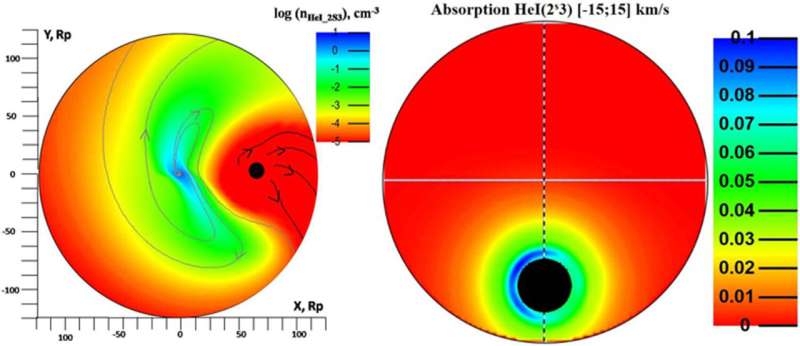This article has been reviewed according to Science X's editorial process and policies. Editors have highlighted the following attributes while ensuring the content's credibility:
fact-checked
peer-reviewed publication
proofread
Researchers report on the atmosphere of hot Jupiter HD 189733b

Scientists from the Institute of Laser Physics of the Siberian Branch of the Russian Foundation for Basic Research have modeled the atmosphere of the well-known "hot Jupiter" HD 189733b and have learned what hindered a stable finding of hydrogen in the atmosphere of the planet. They also defined the physico-chemical properties of this planetary system. They presented on this topic at the symposium of Asian Pacific Geophysical Society in August 2023, and the work is published in The Astrophysical Journal.
Exoplanets are planets beyond the solar system. The most studied of them are from the family of so-called hot Jupiters. They can be compared with Jupiterian exoplanets as far as size and weight is concerned, but orbit their stars 10 times nearer than Mercury orbits the sun.
Such close distance and high temperatures cause atmosphere to escape from planets with ultrasonic speed, and the movement of the atmosphere, and also its content, can be studied with the help of method of transit spectroscopy. This method consists of registration of absorptions of stellar radiation by the planet's atmosphere and enables definition of which elements are present in the atmosphere, allowing researchers to make conclusions about speed and density of various elements.
HD 189733b has attracted researchers and observation time of telescopes for less than a decade. The planet became popular due its blue color, caused by glass (silicate) rains—particles of silicates raised into the atmosphere. One of the most interesting mysteries of this planet was "disappearing" transit in the hydrogen line Lyα—measurements of absorptions in this diapason of wavelength turned out to be rather inconsistent.
A bit clearer is the situation with the IK-line of metastable helium 1083 nm—transit in its locality was observed twice, but with different amplitude. Such changes suggest substantially different regimes of the outflow of planetary matter of HD 189733b, and computer modeling is the most available way of investigating possible causes of changes.
One of the most advanced instruments for modeling of complex of features in the atmosphere of exoplanets and interpretation of transit absorptions in the world was created and developed by scientists from the Institute of Laser Physics of the Siberian Branch of the Russian Foundation for Basic Research.
Having applied it to HD 189733b, scientists found that the most probable cause of unstable absorptions in the hydrogen line Lyα is high activity of the host star, which appears in an increase of radiation flux in the ultraviolet area (FXUV, erg∙cm-2с-1Å-1 for 1 АЕ) and the speed of loss of mass of stellar material. It was discovered that changes in those factors can cause not only variable detections of transit absorption in the hydrogen line due to formation of energetically neutral atoms in strong stellar wind, but also different absorptions in the line of metastable helium.
More information: M. S. Rumenskikh et al, Global 3D Simulation of the Upper Atmosphere of HD189733b and Absorption in Metastable He i and Lyα Lines, The Astrophysical Journal (2022). DOI: 10.3847/1538-4357/ac441d
Journal information: Astrophysical Journal
Provided by Russian Foundation for Basic Research



















